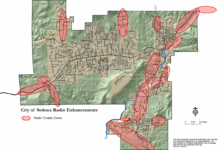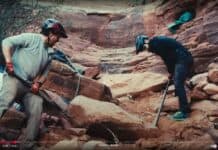If the health of a community is reflected in those who lead it, the Sedona City Council meeting on Tuesday, May 23, told residents and the public at large that Sedona is a combative, toxic, disrespectful community with utter disdain for its residents, its workers, its businesses and business owners and complete disregard for the Verde Valley’s working class.
Tuesday’s council meeting was a disgrace, but not for the residents who came out to speak and not due to Vice Mayor Holly Ploog, Councilwomen Kathy Kinsella, Melissa Dunn and Jessica Williamson and Councilmen Pete Furman and Brian Fultz, who all listened to the public and asked thoughtful questions.
These council members should be applauded for responding courteously and responsibly to both the volunteers and the members of the public.
We have heard complaints from council members and city staff about how meetings have been directed over the last six months, but all those flaws were on full display at Tuesday’s train wreck of a meeting.
Our comments on the proposed ordinance regarding OHVs can wait for a later editorial, but the dismissive and disdainful attitude that our mayor has taken toward residents, the public and the members of the Greater Sedona Recreation Collaborative.
The GSRC is a community organization of residents, neighbors and neighborhoods who have been working with OHV, Jeep and trail business owners for the last two years to reduce environmental damage, noise complaints and overuse on public trails.
After 45 minutes of discussion and presentation, including comments by various community figures, the six aforementioned council members asked probing, important and meaningful questions about the process and its goals, strategies, tactics and what the city could do to help with the process.
Rather than applaud their efforts and offer constructive criticism as to what this group could do better, the mayor was wholly dismissive of their activities, condemned them for their inaction and asked why they hadn’t solved all the problems already.
Considering GSRC is only an advisory body with no powers to do anything — that’s what governments like the Sedona City Council do based on the recommendations of advisory bodies — it’s absurd that the mayor would demand action from a group of residents, from common volunteers like you, dear reader, trying to do something good for the Sedona community, then bash them — while also noting he has been on council for nine years and has also made no progress.
The hypocrisy was deafening.
It was insulting and offensive that the mayor would dismiss not just the 45-minute presentation but the last two years and hundreds of hours of work by this unpaid volunteer organization out of hand, then declare — unequivocally and without conferring with his colleagues — that the organization had lost the entire council’s support.
This autocratic edict was directly contradicted by the previous insightful questions from Ploog, Kinsella, Dunn, Fultz, Furman and Williamson, who should be applauded for the way that they treated this group of their neighbors working on your behalf, dear readers, to reduce the problems of OHVs in neighborhoods.
The next item on the agenda was the mayor’s OHV ban. Before this portion began, the mayor unilaterally declared without previous warning that speakers who had prepared their statements days and weeks in advance would be limited to two minutes instead of the traditional three.
Democracy is a brutal, ugly, lengthy, messy and chaotically beautiful process, which requires hours of debate, discussion, rhetorical strategies and persuasion, but the mayor could not be bothered to listen for more than two minutes to speakers whose very livelihoods depended on the passage or failure of his personal ordinance.
This item wasn’t about a fluffy policy suggestion. It was about law. That legal gravitas demands council should respect at least the three-minute limitation on our free speech and not one second less. Council gets hours to pontificate; these speakers only get their three minutes, and they each deserve the council and mayor’s mitigated attention for all 180 seconds.
The mayor said people could email him if they wanted to say more. The purpose of the public forum is not to persuade council members in private, but to have their statements recorded for the public, for the rest of us to hear. Those three minutes are not the mayor’s clock, nor his time; they belong to the people. To you. And you deserve your time and your First Amendment right to listen to our neighbors.
It is highly disturbing that the mayor limited comment on his personal proposal in an attempt to crush dissent, deprive the public of an opportunity to speak out against it and limit neighbors from discussing how the his own myopic actions may harm them, their employees and their families. Even residents incensed by OHVs finally had a council willing to listen, but the mayor cut them off. If a meeting runs long, a good mayor adjourns and resumes discussion the item the next day.
Better mayors have done it before.
Autocracy is efficient because dissent is silenced.
Democracy is not an episode of television that ends at the top of the hour; it doesn’t end on a wristwatch.
It ends when the people have spoken.
It ends when they are done, and not a moment sooner.
Christopher Fox Graham
Larson Newspapers
You can watch the whole Greater Sedona Recreation Collaborative presentation “8.c. AB 2944 Presentation/discussion regarding Greater Sedona Recreation Collaborative’s (GSRC) work towards improved management and mitigation of impacts of motorized recreational uses in and around Sedona” and questions from Sedona City Council members here. The Greater Sedona Recreation Collaborative’s whose members include the city of Sedona, Yavapai County, Arizona Game and Fish Department, Arizona State Parks & Trails, the Coconino National Forest’s Red Rock Ranger District, Keep Sedona Beautiful and numerous OHV and Jeep tour and rental companies.



















